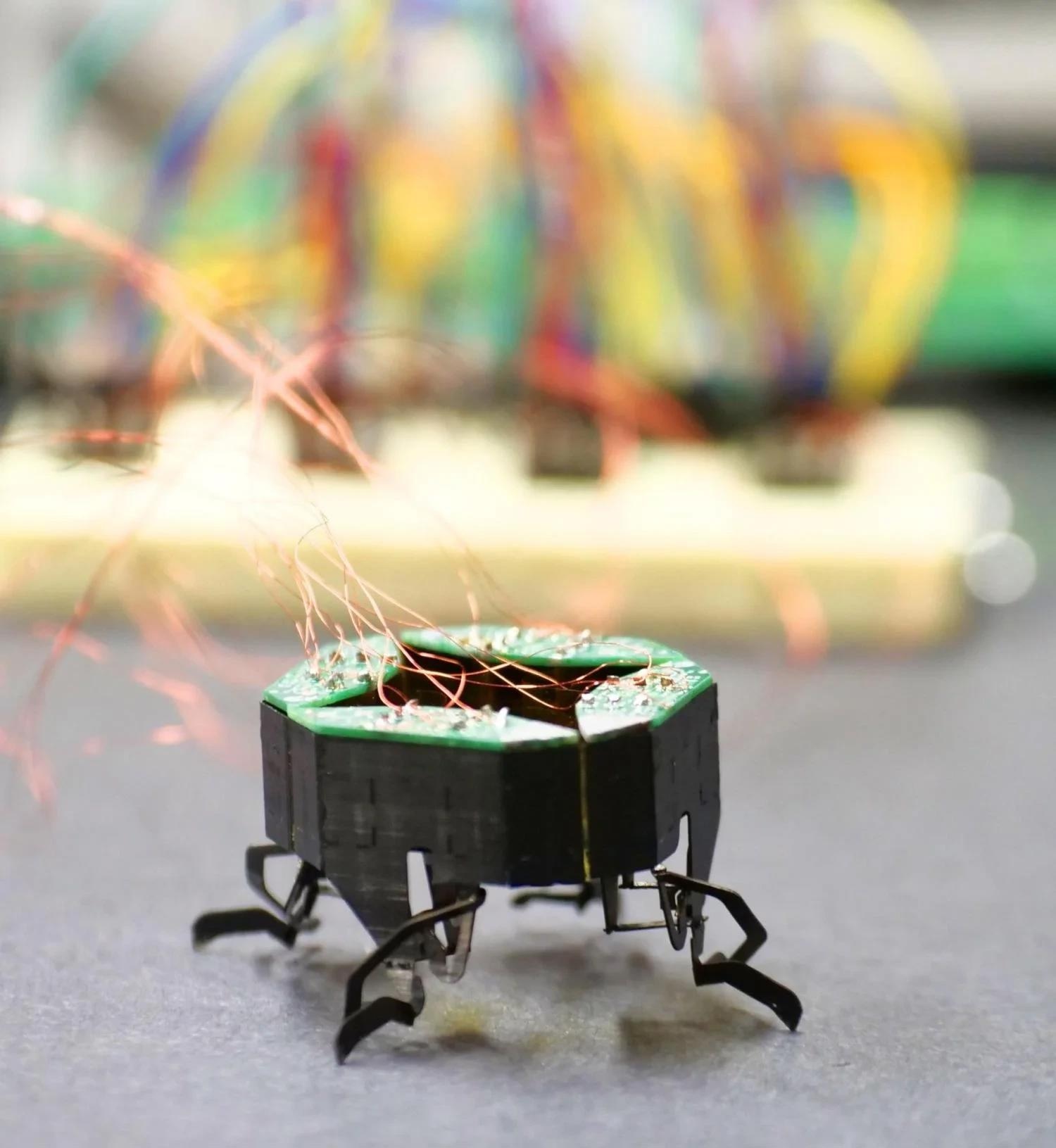The CLARI is a little, squishable robot that has the potential to passively alter its shape to squeeze through narrow gaps—with a bit of inspiration from the world of bugs.

CLARI’s modular design could allow researchers to add more legs to this robot, creating a spider-like machine. Image Credit: Casey Cass/CU Boulder
CLARI, which refers to Compliant Legged Articulated Robotic Insect, comes from an engineering group at CU Boulder. It can assist first responders following significant disasters in a completely new way.
Many of these robots could easily fit in the palm of one’s hand, and each weighs less than a Ping Pong ball. CLARI could transform its shape from square to long and slender when its surroundings become cramped, stated Heiko Kabutz, a doctoral student in the Paul M. Rady Department of Mechanical Engineering.
Kabutz and his collaborators launched the miniature robot in a study published on August 30, 2023, in the journal Advanced Intelligent Systems.
At present, CLARI consists of four legs. However, the machine’s design enables engineers to mix and match its appendages, possibly giving rise to a few wriggly and wild robots.
It has a modular design, which means it’s very easy to customize and add more legs. Eventually, we’d like to build an eight-legged, spider-style robot that could walk over a web.
Heiko Kabutz, Doctoral Student in the Paul M. Rady Department of Mechanical Engineering, University of Colorado Boulder
Still, CLARI is in its beginning stage, added Kaushik Jayaram, co-author of the study and an assistant professor of mechanical engineering at CU Boulder.
The robot, for instance, has been tethered to wires, which supply it with power and transfer its basic commands. However, he hopes that one day, such petite machines could crawl into spaces where no robot has crawled before—like the rubble of collapsed buildings or the insides of jet engines.
Jayaram stated, “Most robots today basically look like a cube. Why should they all be the same? Animals come in all shapes and sizes.”
Cockroach Power
Jayaram is no outsider to robots that consider the hodgepodge of the animal world.
As a graduate student at the University of California, Berkeley, Jayaram developed a robot that could squeeze via narrow spaces by compressing down to around half its height—just like cockroaches stick their way through cracks in a wall.
However, that machine, he stated, represented just the tip of the iceberg where animal flexibility is taken into account.
Jayaram stated, “We were able to squeeze through vertical gaps. But that got me thinking: That’s one way to compress. What are others?”
This is where CLARI, made to squeeze through horizontal gaps, enters the picture.
In its basic form, the robot is shaped like a square with one leg together with each of its four sides. Based on how one squeezes CLARI, it could become wider, like a crab, or highly elongated, like Jayaram’s old favorite, the cockroach.
Altogether, the robot could morph from around 34 mm (1.3″) wide in its square shape to around 21 mm (0.8″) wide in its elongated form.
Contrary to Jayaram’s earlier mechanized cockroach, each of CLARI’s legs functions almost like an autonomous robot—with its circuit board and dual actuators that move the leg forward and backward and side-to-side, just like a human hip joint. In a theoretical way, that modularity might enable CLARI robots to take on an extensive range of shapes.
What we want are general-purpose robots that can change shape and adapt to whatever the environmental conditions are. In the animal world, that might be something like an amoeba, which has no well-defined shape but can change depending on whether it needs to move fast or engulf some food.
Kaushik Jayaram, Study Co-Author and Assistant Professor of Mechanical Engineering, University of Colorado Boulder
Web Crawler
Jayaram and Kabutz observe their present design as the first in a series of CLARI robots that they believe will become smaller and highly nimble.
In future iterations, the scientists wish to integrate sensors into CLARI so that it has the potential to detect and react to obstacles. Also, the group is analyzing how to provide the robot with the correct mix of strength and flexibility, stated Kabutz—a task that will just get harder the more legs the team adds on.
Ultimately, the team wishes to come up with shape-changing robots that do not just move through a laboratory environment but a complicated and natural space—in which the machines will be required to bounce off hindrances like trees or even blades of grass or push via the cracks between rocks and continue.
When we try to catch an insect, they can disappear into a gap. But if we have robots with the capabilities of a spider or a fly, we can add cameras or sensors, and now we’re able to start exploring spaces we couldn’t get into before.
Heiko Kabutz, Doctoral Student in the Paul M. Rady Department of Mechanical Engineering, University of Colorado Boulder
Journal Reference
Kabutz, H & Jayaram, K (2023) Design of CLARI: A Miniature Modular Origami Passive Shape-Morphing Robot. Advanced Intelligent Systems. doi.org/10.1002/aisy.202300181.